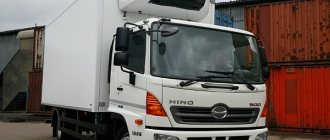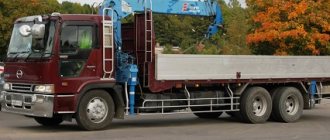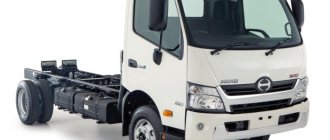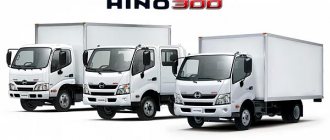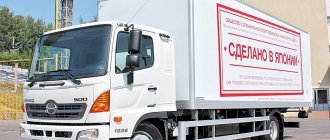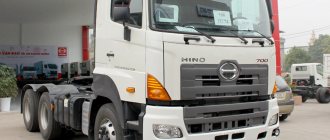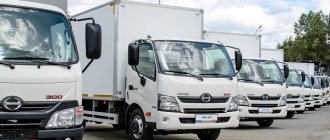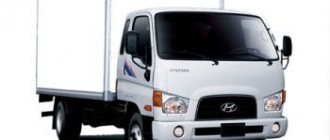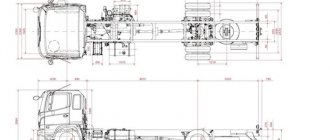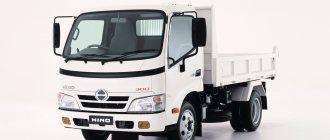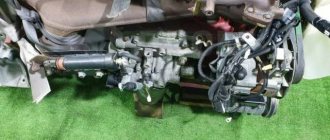| This article raises many issues. Please help | This article no information about 5th/6th generation trucks. . |
| This article need additional quotes for verification . |
(Learn how and when to remove this message template)
| Hino Ranger Hino 500 series | |
| Review | |
| Manufacturer |
|
| Also called |
|
| Production | 1964–present |
| assembly |
|
| Body and chassis | |
| Class |
|
| Body type |
|
| Transmission | |
| Engine |
|
| Transmission of infection |
|
The Hino Ranger
(Japanese: 日野レンジャー) is a medium to heavy-duty commercial truck produced by a Japanese automaker. Hino Motors since 1964
Outside Japan, it is also known as the "500 series" and as part of the "F series", "G series" and "S series". There was also a partial split into a heavier and lighter range, with the latter distinguished by various prefixes or suffixes such as "Day Cab Ranger" or "Ranger 2". In some countries, the Ranger was only available as a medium or heavy-duty truck before light-duty models such as the FA and FB were replaced by Hino Dutro.
1st generation (1964–1983)
First generation Hino Ranger (second facelift model)
The first Hino Ranger appeared as the 3.5-ton "Ranger KM300" in June 1964, landing in the newly competitive middle-weight truck category in Japan.[1] There was also a short wheelbase model called the KM320. The long-wheelbase KM340 appeared in December, and in 1966 the cab became a three-seat (rather than a two-seat). The first model had a body-color grille and separate headlight surrounds; this was changed in November 1967 when the headlights were integrated into the grille. Until they were replaced in 1968, the Ranger had suicide doors. In November 1969, the design was changed again, now with two headlights in the grille, painted in a contrasting color. More importantly, the cabin has been extended by 55 mm (2.2 in), improving comfort. The Ranger KM was not in great demand as its payload capacity was 3,500 kg (7,700 lb) while the licensing system favored 4-tonne trucks.[1]
The original engine produced 90 hp. (66 kW). With the 1967 facelift came ten extra horsepower, although the DM100's six-cylinder engine was still 4,313 cc. cm (263.2 cu in).[2] In April 1971, wheelbases were changed across the range, meaning new model numbers: KM310 (regular), KM330 (short) and KM350 (long).[3] In April 1978 the engine was switched to the new DQ100 and various safety improvements were introduced (high-back seats, larger rear-view mirrors). The volume of the new DQ100 engine was 4507 cc. cc (275.0 cu in) and power increased to 110 hp. (81 kW). The line was now designated the KM500, with a short wheelbase (commonly sold as a tipper) called the KM520 and a long wheelbase model called the KM540.[4]
In 1978, the 2-ton Hino Ranger 2
was launched, renamed Toyota Dyna (also sold as Daihatsu Delta) with Daihatsu or Toyota engines.
Then a 3-ton version appeared, called Ranger 3
.
By the end of 1979, the name Ranger KM was changed and it became the Hino Ranger 3M
.
The Ranger also met the latest (1979) emissions regulations. When emissions were tightened again in 1983, the Ranger 3M received the latest modifications to match them and now featured a chrome-edged grille. The KM ceased production in 1984 as it was replaced by the Day Cab Ranger.
[1]
Cabin Hino 500
On all modifications, the cabin is installed the same: with a low roof, three seats and a compact but full-fledged sleeping place behind them. The design of the head of the HINO 500 is made in a typical oriental style. The appearance is dominated by decorative lines emanating upward from the bumper; Unusual are the direction indicators, separated from the headlights. When moving, the windshield wiper blades diverge in opposite directions.
The cabin interior clearly illustrates the love of Japanese engineers for compactness and practicality in everything. The cabin seats 3 passengers and is quite spacious inside. Everything here is made of high quality materials. There is a compact sleeping area behind the seats. It can hardly be used for long trips, but for a short vacation it is quite suitable. There is no unnecessary or superfluous information on the dashboard. Its design of the Hino 500 resembles a passenger car. The cabin clearly demonstrates the Japanese specialists' love for compactness. At the same time, the inside is quite convenient and comfortable, especially for the driver.
The driver’s workplace is organized according to the principle of dominance of reasonable sufficiency – the proprietary concept of “Roundish & donut cabin”, which can be translated as “rounded and flat space”. The basic color of the cabin is white. A comfortable individual driving position (both the seat and the steering column are adjustable) allows the driver to feel like he is in charge of the situation. In addition to several settings options, the driver's seat is also equipped with a retractable armrest and a standard pneumatic shock absorption system.
The interior finishing materials are clearly inexpensive and discreet. However, all the plastic and upholstery of the seats look very decent, and the panels fit together almost perfectly. The visibility from the cabin is excellent in all directions. Spherical mirrors located on the right practically eliminate the presence of dead zones.
3rd generation (1980–1989)
Hino Ranger FF173, post facelift
Introduced in Japan in 1980, early models (marketed as Wind Ranger
in Japan) have dual round headlights, while the facelift models (sold as
Ranger +5
and
ONE UP Ranger +5
in Japan) come with thinner rectangular units. The range of engines has also been updated. The cabin design was inspired by European trucks and was 35 percent more aerodynamic than its predecessor, according to Hino. The cabin was assembled by robots.[5]
Beginning in 1982, Ford Motor Company and Hino signed a contract to supply badged trucks that would be known as the Ford N series for release in the Australian and New Zealand markets to replace the Ford D series trucks. The deal lasted 15 years.
From 1988 to 1998, the third generation Ranger was produced under license by Kia Motors and sold as the first generation Kia Rhino in South Korea.
The third generation Ranger was the first Hino model sold in the United States with the first FE17, FE19, FF17, FF19, FG19 and FG22 variants introduced in 1983 as a 1984 model.[6] In North America, the Ranger name was not used and all trucks were sold under their own model numbers. After 1987, the range consisted of four-cylinder Day Cab Ranger Models FA and FB (Class 3 and Class 5 respectively), the larger Class 5 Hino GC (six-cylinder 160 PS diesel), Class 6 FD with the same engine and the larger FE with turbocharged (still class 6).[7] The heaviest Hinos sold in the United States were the Class 7 FG and SG series, also part of the Ranger family.[8] Production of the third generation for the North American market ended in 1992, when it was replaced by a fourth generation model.
Production of Japanese models began to decline in 1989 (export models and special use versions continued to be produced until at least 1992), while Indonesian models continued until 2003.
Indonesia
Models in Indonesia are FF172, FF173, FL176, FM226 and SG221. FF and SG were sold as Super Ranger
, FL and FM
Jumbo Ranger
. The well-equipped FF Super Ranger was introduced in late 1985 and offered features such as dual circuit power brakes, tilt steering wheel and a 175bhp diesel engine. (129 kW).[9]
Day Cab Ranger (1984–1995)
Hino Day Cab Ranger (facelift model)
Production of the original KM Ranger series was finally discontinued as the new mid-duty Day Cab Ranger debuted in June 1984. Unlike competitors from other manufacturers who used cabs from their light trucks, the Day Cab Ranger was specially designed. It was available as a 3.5 ton ("3B") or 4.5 ton ("4C"). All available engines were diesel: 4,009 cc (4.0 L) W04D
four-cylinder, 5.759 cc (5.8 L)
W06D
six-cylinder or 6.728 cc (6.7 L)
H07C
heavy-duty.[10] Power output was 115 hp. (85 kW) for four-cylinder engines, 145 and 175 hp. (107 and 129 kW) for six-cylinder engines. In November 1988, the Day Cab Ranger was updated with a new, sleeker grille.
In May 1990, the Day Cab Ranger was completely redesigned, with new glass doors and a new front end treatment. The engines now meet 1989 emissions standards. In W04D
remained, although power was increased to 120 hp.
(88 kW), while the W06D
was replaced by the 6,014 cc (6.0 L)
W06E
producing 165 hp.
(121 kW) and the H07C
was replaced by the 7,412 cc (7.4 L)
H07D
producing 195 hp.
(143 kW). The 3B and 4C names were dropped and they were now primarily called Ranger FB and Ranger FC. In 1995, the Day Cab Ranger was replaced by lighter versions of the (fourth generation) "Rising Ranger", although production continued in North America until the end of the 1997 model year. In the North American market, Day Cab Rangers were sold as the Hino FA and FB, equipped with a 125 hp version. (93 kW) W04D
engine.[7]
1984 was marked by the appearance of the second generation Ranger 2/3
, a series of two- and three-ton trucks that were actually rebadged Toyota Dynas.
Reviews from Russian owners and drivers about the Hino 500
All owners and drivers of trucks of this model note that they are designed absolutely without any complications, in a simple way, but in a Japanese way, scrupulously and reliably. This manifests itself in many details. Ease of use lies in the details. For example, the aluminum running boards are molded to provide maximum clearance for dirt to clear off your shoes. The handrails are designed at an acceptable height, due to which entry and exit does not cause problems.
The steering column is adjustable in two directions, which increases the adaptability of the workplace, everyone praises it, although of course the decoration and equipment of the cabin are called Spartan.
No one has any complaints about the performance and reliability of both the engine and gearbox, as well as the engine brake and main drum brakes. On the highway, according to user reviews, a loaded car can reach a maximum speed of up to 100 km/h.
The reliable engine works without strain, thanks to the successful selection of power and torque. This engine is not at all demanding on the quality of fuel and will even digest dubious diesel fuel purchased in remote regions without consequences.
There are no problems with the injection pump and fuel injectors. This car is easy to maintain. A minimum of electronics and a simple design allow you to perform most of the maintenance yourself and save on visits to certified service stations. Drum brake linings “go” for at least 100 thousand km, and even more if out-of-town flights predominate.
The performance of ABS systems and especially ASR received kind words from drivers and owners. The standard stove is quite efficient, but many residents of the northern and Siberian regions still prefer to install an additional liquid heater or air heater.
Many also say that it would not be superfluous to add rear parking sensors to the standard equipment of the car. However, parking sensors are included in the list of additional options, and you can install it yourself. The downside is that there are problems with spare parts. In Russia we have relatively few suppliers of parts for this car. And if in the Far Eastern regions of the country there are no problems with purchasing spare parts, then in the central and western regions it can be difficult to get them.
In general, Russian owners speak of the HINO 500 as a truck that is designed to work without downtime, as an unpretentious workhorse. If handled correctly, the Hino 500 will regularly generate profits and not be bothered by breakdowns. And this is the most important thing for anyone involved in the transport business.
4th generation (1989–1999), Space Ranger (1999–2002)
Hino MFD 950 (Pre-facelift) Hino Rising Ranger (First facelift) Hino Space Ranger (Second facelift)
In Japan, the fourth generation Ranger was introduced in 1989 and marketed as the Cruiser Ranger
, then
Rising Ranger
and
Space Ranger
after each of two facelifts in 1994 and 1999 respectively. The lightweight models, introduced in 1995 as part of the Rising Ranger line, replaced the earlier Day Cab Ranger as all models were standardized.
- Light truck: FA, FB
- Light medium trucks: FC, FD, FE, GD
- Medium heavy truck 4x2: FF, FG
- Medium truck 4x4: FT, GT, GX
- Tractor head: SG
The Dakar Rally winning Ranger FT97 on display
Hino entered three Ranger FTs in the 1997 Dakar Rally and overall results were 1-2-3 in the Camion (truck) category.
In North America, Hino continued to use model numbers instead of Ranger
the name of your medium truck. Introduced in 1992 as a 1993 model, the initial models were the FD2218, FD2218LP, FE2618, FF3018, FF3020, SG3320, SG3323, and SG3325.[6] The range was updated in 1997 for the 1998 model year with a minor facelift, new engines, new gross vehicle weights and new passenger models, namely the FA1517 and FB1817. The updated mid/mid range consisted of the FF2220, FD2320, FE2620, FF3020, SG3320 and SG3325.[11] The first two digits indicate the gross vehicle weight rating (GVWR), and the last two digits refer to engine power. FA1517 refers to the smallest truck, weighing 15,000 lb (6,804 kg) and producing approximately 170 hp. (127 kW). The fourth generation was the last generation of Ranger sold in North America, replaced by the 600 series after being discontinued after the 2004 model year.
Production of Japanese models began to decline in 2002 (export models and special purpose versions continued to be produced until at least 2004).
The fourth generation Ranger was not sold in Indonesia as the third generation was produced locally until 2003. From 1998 to 2003, the fourth generation Ranger was produced under license by Kia Motors and sold as the second generation Kia Rhino in South Korea.
Modification GD / 12 tons (7 options)
- Chassis curb weight: 3.97 t; 3.98 t; 4.055 t; 4.155 t; 4.1 t; 4.185 t; 4.125 t.
- Chassis load capacity: 8.03 t; 8.02 t; 7.945 t; 7.845 t; 7.9 t; 7.815 t; 7.875 t.
- Wheelbase: 3.75 m; 4.25 m; 4.85 m; 5.15 m.
- Overall length: 6.78 m; 7.39 m; 8.24 m; 8.74 m.
- Rear overhang: 1.7 m; 1.81 m; 2.06 m; 2.26 m.
- Rear chassis height: 0.875 m or 0.84 m.
- Turning radius on wheels: 6.9 m; 7.7 m; 8.6 m; 9.1 m.
- Turning radius from wall to wall: 7.6 m; 8.4 m; 9.3 m; 9.8 m.
All seven options have the same values:
- total weight – 12 tons;
- load on the front axle – 3.9 t, on the rear axle – 8.1 t;
- width – 2.355 m and height – 2.495 m;
- ground clearance (differential) – 200 mm;
- track width: front – 1.76 m, rear – 1.69 m.
- tire size – 265/70R19.5.
5th generation (2001-present)
Hino Ranger Hino Ranger FG 6×4 (Heavy Duty Concrete Mixer) Hino Ranger SG 4×2
Ranger 5th generation sold in Japan as Ranger Pro
, or
Hino 500 series
for export.
In Indonesia, Super Ranger
and
Jumbo Ranger
names were used on the locally produced third generation model which it replaced.
In Malaysia, it was called Validus
.
The Ranger series was marketed as Hino. Mega
to Thailand. The fourth generation lightweight FA and FB models sold in some markets were discontinued in this generation and replaced by the 300 series or lightweight versions of the 600 series.
In Australia, the Ranger was sold as the "Ranger Pro" until 2008. Thereafter it was sold as the Hino 500 with new engines and transmission options.[12]
The Ranger was available in a variety of cab combinations, standard or wide, standard or high roof, short or full cab. The FD is also available in a double cab version.
A High class
A package with a chrome bumper, HID headlights, wood fascia and other interior upgrades is offered in the Japanese domestic market.
- Light medium trucks: FC, FD, GD, FE
- Medium heavy truck 4x2: FF, FG, FJ
- Medium truck 4x4: FT, FX, GT, GX
- Medium Heavy Truck 6x2: FL
- Medium heavy truck 6x4: GK, FM
- Medium Heavy Truck 8x4: GY
- Tractor head 4x2: SG
- Tractor head 6×2: SG
- Tractor head 6×4: FM
A diesel-hybrid-electric version is also available in Japan.
Device
The design of Hino Ranger meets high quality requirements. The cabin is both functional and comfortable. For the driver, the developers have provided a seat with a separate air suspension. A seating area and air conditioning are already available in the basic version. The instrument panel is located quite low, which increases frontal visibility. The driver is located in close proximity to the main switches and controls.
The Hino Ranger is equipped with two types of rear suspension - pneumatic and spring. To reduce the loading height, tubeless low-profile tires with a wheel diameter of 17.5 inches are used. Single leaf springs used in the truck allow you to extend its service life. They feel great on uneven terrain and off-road. Thanks to the reinforced frame design, the correct distribution of increased loads is achieved and the integrity of the structure is maintained.
The owners of the Hino Ranger noticed that the model is capable of carrying a much larger load than the declared one. However, experts do not regularly recommend using a car with a maximum weight limit, as this can end in disaster. The chassis of the vehicle is of improved quality and can last up to 500,000 km without problems, even on Russian roads. For it, it is enough to periodically lubricate some elements.
The Hino Ranger body is coated with special compounds that protect against external influences and corrosion during regular use. The blocks are additionally protected from dirt and dust. This increases the overall work resource. It is adaptation to difficult working conditions that is considered one of the main advantages of a car. So, the truck functions normally on Russian fuel.
In the basic configuration, the Hino Ranger is equipped with a 4-spring cab suspension, air conditioning, electric windows, power steering, sleeper, air suspension and heated driver's seat, fog lights, central locking, heated mirrors, ABS, ASR, pneumatic braking system and an electric cab lift system.
The Hino Ranger is mostly available in right-hand drive versions. Conversion to left-hand drive is very expensive, since adaptation requires the replacement of about 60 elements. In addition to moving the steering, it will be necessary to change the ventilation system, engine shield, headlights, dashboard and move the pedal unit. Economically, this procedure is very unprofitable.
Another disadvantage that drivers regularly complain about is the cold cabin. In sub-zero temperatures, the comfort of working in a car decreases sharply. The stove functions normally in exceptional cases (sometimes replacing antifreeze helps).
Hino Ranger is equipped with a generator without a brush assembly. This design is convenient because it practically does not break. There is no need to purchase additional spare parts for the element. The only thing that can fail is the bearings.
About spare parts
Spare parts for a car are not cheap, and you can’t buy them everywhere (mostly, to order). Since the Hino Ranger is not very common on the Russian market, used parts will also not be easy to obtain. The model is aimed at the Japanese market, so sometimes you have to wait a long time for original spare parts. In some cases, after accidents and accidents, it is much easier and more profitable to sell a Hino Ranger than to try to restore it. True, this is not true for all regions of the country. In the Far East, on the contrary, there are much more problems with parts for European cars than with spare parts for Japanese ones. When purchasing a car, you should check whether services and spare parts for this brand are available in the region.
Despite its shortcomings, the Hino Ranger remains one of the highest quality vehicles in the commercial segment.
Motorsport
The Hino Ranger Dakar truck from Team-Sungawara
The Ranger made its debut in motorsport in the 1991 Dakar Rally. In 1997, Rangers, represented by the Hino factory team, finished the Dakar Rally in 1-2-3 positions. The Ranger would dominate the 10-litre class until 2002, when it was axed. After the class was reinstated in 2005, the Ranger won its class in the 2005 season and took another class win in the 2007 season. Ranger continued to record victories between 2010 and 2022.[13]
Modification GH / 17.5 tons (6 versions)
- Chassis curb weight: 5.355 t; 5.29 t; 5.525 t; 5.355 t; 5.615 t; 5,505 t.
- Chassis load capacity: 12.145 t; 12.21 t; 11.975 t; 12.145 t; 11.885 t; 11,995 t.
- Wheelbase: 4.62 m; 5.51 m; 6.2 m.
- Overall length: 7.57 m; 9.46 m; 10.55 m.
- Rear overhang: 1.91 m; 2.55 m; 2.95 m.
- Rear chassis height: 1.06 m or 1.02 m.
- Turning radius on wheels: 7.8 m; 9.8 m; 10.9 m.
- Turning radius from wall to wall: 8.5 m; 10.5 m; 11.6 m.
All seven options have the same values:
- total weight - 17.5 tons;
- load on the front axle – 6.5 t, on the rear axle – 11 t;
- width – 2.47 m and height – 2.685 m;
- ground clearance (differential) – 245 mm;
- track width: front – 1.925 m, rear – 1.84 m.
- tire size – 295/80R22.5.
Recommendations
| Wikimedia Commons has media related to Hino Ranger . |
- ^ a b c
Route ★ ZERO (2014-02-23).
"【Hino Ranger KM】これが最初のレーなのだ" [Three-wheeled soft-top scooter (Hino Ranger KM)].旧式的用車図鑑 [Illustrated Old Commercial Vehicles]
(in Japanese). Archived from the original on 2019-08-30. - 自動車ガイドブック 1968年~69年新
[
Japan Automobile Guide 1968/1969
] (in Japanese),
15
, Japan: Japan Automobile Manufacturers Association, 1968-10-25, p. 201 - 自動車ガイドブック: A Guide to Japanese Cars 1972–73.
(in Japanese),
19
, Japan: Japan Automobile Manufacturers Association, 1972-10-23, pp. 241, 253 - 自動車ガイドブック
[
Japan Automobile Guide 1978/1979
] (in Japanese),
25
, Japan: Japan Automobile Manufacturers Association, 1978-10-10, pp. 234, 256, 0053-780025-3400 - Mallett, Chris (May 1982). "Down with debutants." TRUCK
. London, UK: FF Publishing Ltd: 43. - ^ a b
“Hino Parts Quick Reference Guide, Model Year 1984–1997” (PDF).
hino.com
. Hino Trucks. Retrieved September 10, 2022. - ^ a b
Mel, Jim (July 1990).
"New Models for 1991: Midsize Trucks." Fleet owner
. Vol. 85 no. 7. Business publications FM. paragraph 71. - Dwyer, John J. (July 1990). "New Models for 1991: Medium Trucks." Fleet owner
. Vol. 85 no. 7. Business publications FM. paragraph 85. - Susanto, Tias, ed. (1985-11-11). "Baru: Hino Super Ranger" [New: Hino Super Ranger]. Mobil & Motor
(in Indonesian). Vol. XV no. 10. PT Inscore Indonesia. paragraph 29. ISSN 0047-7591. - 自動車ガイドブック
[
Japan Car Guide 1984~'85
] (in Japanese),
31
, Japan: Japan Automobile Manufacturers Association, 1984-10-20, pp. 254–255, 0053-840031-3400 - "Hino Parts Quick Reference Guide: Model Year 1998-2004 Edition" (PDF). hino.com
. Hino Trucks. Retrieved September 10, 2022. - "2008 Hino 500 Range". Hino Australia
. 2008-03-01. Retrieved 2020-07-29. - "History and Report of the Races". hino-global.com
. Hino Motors. Retrieved October 14, 2022.
Price HINO 500
New Hino 500 trucks are offered in Russia at prices starting from 5,500,000 rubles. The warranty on new HINO 500 trucks is 24 months or 100 thousand km, whichever comes first. For used cars of this model they ask from 2.5 to 4.5 million rubles.
Currently, Russian carriers put about four dozen bodies on the HINO 500. The most popular of them are an isothermal and manufactured goods van, an onboard platform and a platform with crane-manipulator installations. It’s less common to see curtain-sided “sides,” and even a little less common are tow trucks, garbage trucks, dump trucks, and concrete mixer trucks.
Reviews note that, thanks to the large steering angle of the front wheels, power steering and decent visibility, it is very easy to drive the car. Perhaps the greatest number of kind words in positive reviews is about the excellent maneuverability of these trucks.
